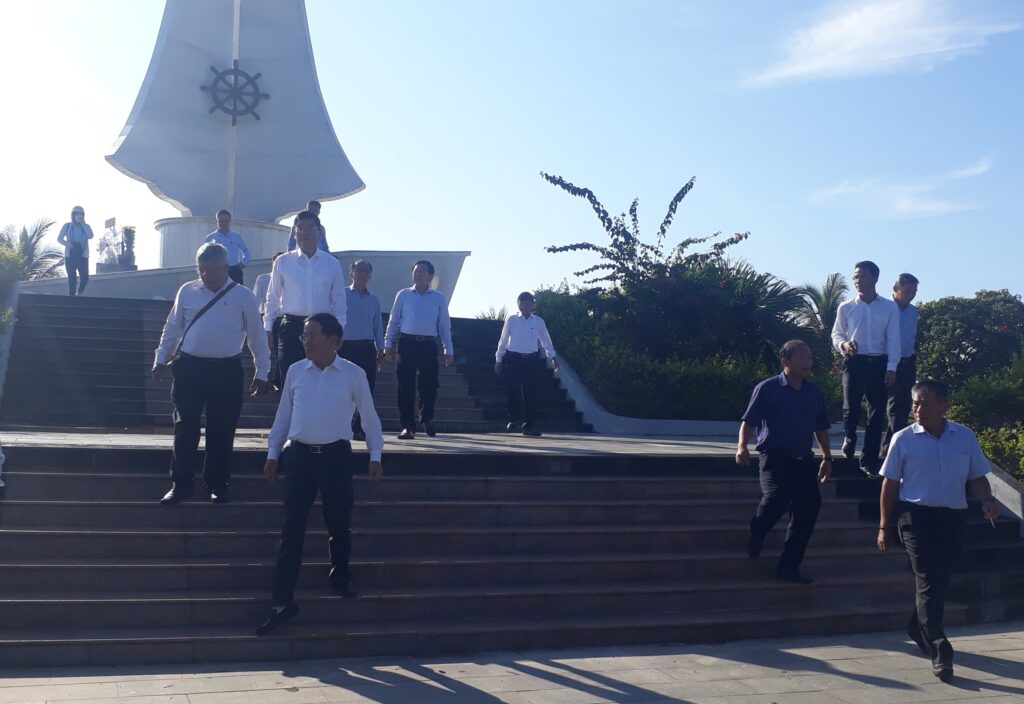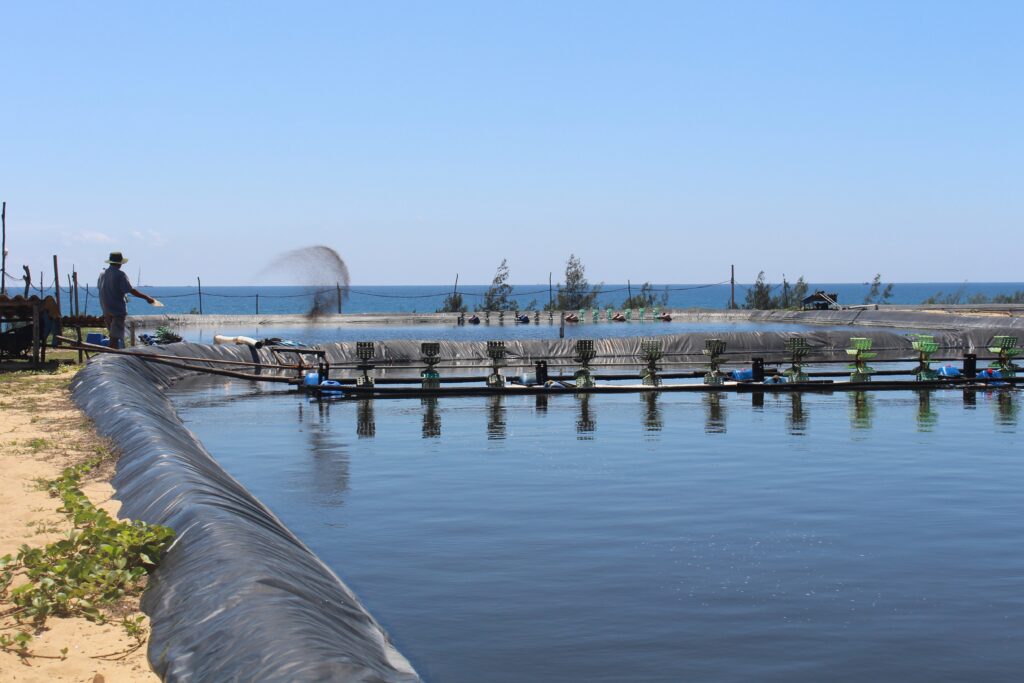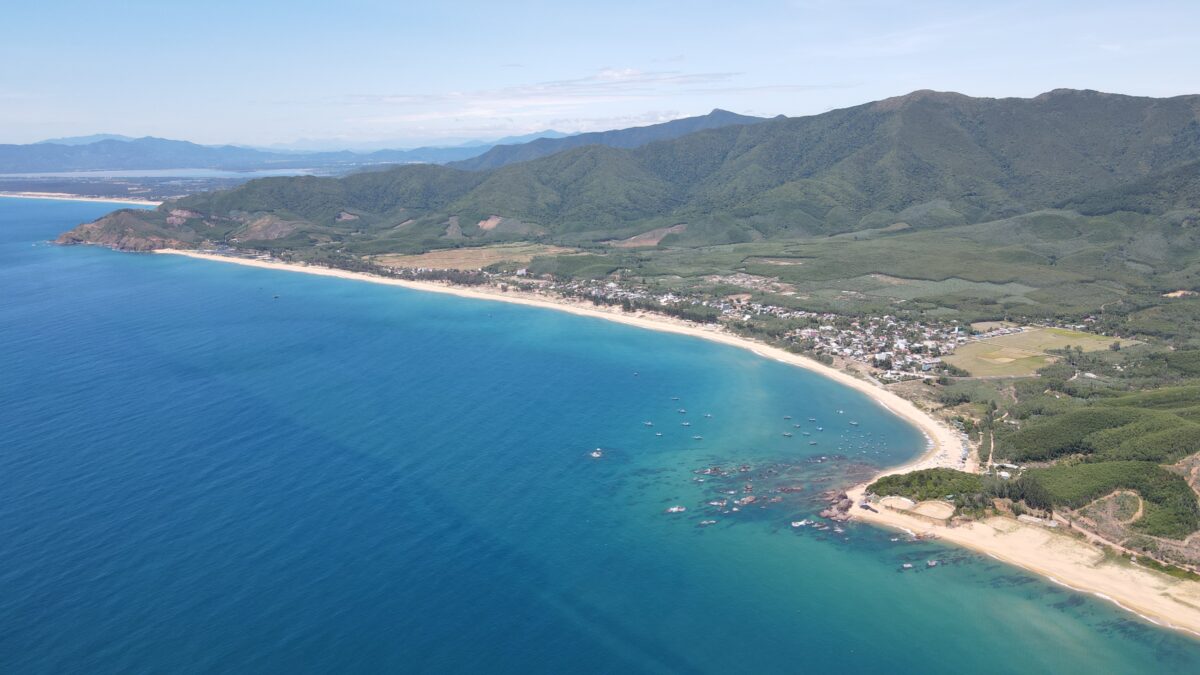BINH DINH, VIETNAM – On May 30, 2023, when the people of Lo Dieu village gathered under a white marquee to hear Binh Dinh province officials and investors talk about the proposed US$2.6 billion Long Son iron and steel project, there was outrage when the meeting ended 45 minutes early, before many had a chance to voice their opinions.
Villagers were left disappointed at the abrupt end to the meeting because they faced the prospect of mass displacement to make way for the project – women had abandoned their farms and men stopped fishing for the day to attend this important meeting.
“Why did you end the meeting so soon? We demand to speak more,” village resident Tran Thi My Phung protested as the rest of the crowd objected loudly.

During the meeting, Pham Anh Tuan, the chairman of the Binh Dinh Provincial People’s Committee, reiterated that the project would only proceed with community consent. However, after the meeting, Tuan told Mekong Eye that if the objections continued, the authorities would “have to convince the dissenters to support the project by all means.”
Spanning approximately 1,000 hectares and with an annual capacity of 5.4 million tons, the Long Son complex will rival Hoa Phat, Vietnam’s largest iron and steel project in terms of both capacity and investment, if it comes to fruition.
However, widespread concern among the 3,000 Lo Dieu residents over the loss of ancestral land, the disruption to their livelihoods and the negative impacts on aquatic and groundwater resources, beg the question of whether the coastal province truly needs a big industrial project.
A preliminary environmental impact assessment has been carried out for the Long Son iron and steel project and its construction is awaiting approval from the Ministry of Natural Resources and Environment and the Ministry of Planning and Investment.
If approved, the first of the complex’s three phases will be completed by the end of 2024.
In June, representatives for the Lo Dieu residents sent a petition to the central government, but were instructed by the Central Office of Public Reception to resend the petition to the authorities in Binh Dinh province. The residents complied and as of August 2023, their case was still pending.

A loss of livelihoods
Throughout its 500-year history, Lo Dieu has been a relatively serene coastal community, except during the two Indochina wars when it endured numerous losses and hardships.

In the 1960s, the village served as a crucial port for North Vietnam’s unnumbered ships to deliver weapons to their southern counterparts during the second Indochina war. By providing support for the revolution, Lo Dieu lost many residents.
When the war ended in 1975, the village had only about 150 households and 141 had died in the war, each household having lost at least two to three in battle. Today, the village has 563 households.
“Lo Dieu occupies an important strategic military position,” said war veteran Ho Thanh Nam. The village is isolated, nestled in a valley between two mountain passes and facing the sea. During wartime, only strategically significant military sites were designated as docking points for unnumbered ships.



Today Lo Dieu is home to more than 3,000 people, most of whom earn a stable living. While young fishermen sail as far as the Paracel and Spratly islands, older men and women fish near the shore, farm and tend to the forests where they source timber.
According to the General Statistics Office of Vietnam, Lo Dieu’s annual per capita income from 2018 to 2022 ranged between $2,015 and $2,225, higher than the national rural average in the same period.
The village’s monthly per capita income is also higher than Binh Dinh province’s average and the province’s rural average.
“We have a peaceful life here. We can choose to farm, work in the mountains or go to sea to make a living,” Tran Thi My Phung, a farmer whose family members fish near the shore, told Mekong Eye.
Tran Thi Lan, another coastal fisherman whose family earns between $17 and $63 per day from coastal fishing, agreed.
“With rich biodiversity and surrounded by mountains, this area remains undisturbed by pesticides and is a great location for herbal farming,” one resident, identified only as MVH, told Mekong Eye.
“The locals do not use pesticides. We are collaborating with different partners to promote ecological and technological tourism by farming native medicinal plants.”
According to village deputy head Huynh Xuan Khuong, Lo Dieu now has 180 fishing boats, 1,300 hectares of forests and 82 hectares of crops.
To make room for the iron and steel project, in March 2023 the People’s Council of Binh Dinh province approved the conversion of 267 hectares of forest in Lo Dieu, 2.5 hectares of which are protected forests.
Also, according to the provincial plan, all villagers will be relocated to Bang Bang, a coastal section belonging to Lo Dieu and approximately 1 kilometer from the current residential area. Despite the proximity, locals have avoided settling in this area for centuries due to its large waves and a multitude of coastal sinkholes.
The plan also restricts residents to farming in only four locations, each 5 to 7 kilometers from Bang Bang. Locals find this an additional challenge to the unfavorable natural conditions of the proposed resettlement area.
“How can we ensure long-term livelihoods for those engaging in fishing, agriculture and forestry in the resettlement areas? The deep-water port with frequently docking vessels will affect coastal aquatic resources. Residents will no longer be able to fish,” said villager Nguyen Phi Ho.


Environmental degradation
The iron and steel industries carry the highest risks of pollution in Vietnam. The Binh Dinh provincial authority said it chose to develop the Long Son complex in the expectation that it would boost the local economy.
“Binh Dinh needs flagship projects to pave the way and boost growth. We will not compromise the environment for economic development,” Pham Anh Tuan, the chairman of the Binh Dinh People’s Committee, said during the meeting with Lo Dieu residents in May.
Provincial Secretary Ho Quoc Dung echoed this sentiment, adding that the investor would use coke dry quenching (CDQ), a technology that uses negative pressure furnaces to minimize emissions into the environment.
“[The production system] is completely closed-loop and emission-free,” he assured residents.
However, Tran Tam, a professor from the University of New South Wales with nearly 40 years of experience in researching mineral production and industrial waste treatment, contested Dung’s statement.
“Regardless of the coke quenching technology (wet or dry), iron and steel production have negative impacts on the environment. Coke dry quenching is not new and is currently used by many steel plants,” Tam explained.
He added that all coke quenching processes emit dust and volatile organic compounds (VOCs) that include hazardous chemicals such as benzene and polyaromatic hydrocarbons (PAHs). In addition, most iron and steel factories typically discharge 5-10% of treated wastewater into the environment.
Tam estimated that with an annual capacity of 5.4 million tons of steel per year, the Long Son complex would be discharging between 8 and 16 million cubic meters of treated wastewater into the sea.

“I do not understand how the Long Son project can be a closed loop. How will contaminants and hazardous metals such as chromium, cadmium and iron be collected and treated?” Tam asked.
Even with more environmentally friendly technologies that omit the polluting coke-quenching process such as hydrogen-based production or steel recycling, Tam maintained that a certain degree of negative environmental impacts persisted. The question remained – to what extent?
The project’s major investor, the Long Son Phu My Iron and Steel Company, refused to respond to Mekong Eye’s requests for comment.
A necessary trade-off?
According to the Ministry of Industry and Trade’s report on Vietnam’s steel industry development strategy to 2030, vision to 2050, steel is regarded as an industry with limited competitive capacity.
Most inputs such as iron ore, scrap steel, bituminous coal and graphite need to be imported and their prices are highly dependent on the global steel billet price.
Research in 2021 led by Nguyen Thi Minh Phuong of the National Economics University on the steel industry’s solvency revealed that most steel businesses in Vietnam were competing through price.
This strategy does not lead to high profits, despite shortening the capital turnover, reducing debt collection time and the inventory holding period.
Pham Khanh Nam, an Associate Professor and Director of the Economy and Environment Partnership for Southeast Asia (EEPSEA), emphasized a necessity for a cost-benefit analysis (CBA), in addition to an Environmental Impact Assessment (EIA), when it comes to the construction of industrial projects like Long Son.
Cost-benefit analyses, Nam argued, can quantify the costs of environmental impacts and incorporate intangible costs such as the loss of cultural heritage and historical significance. For example, the loss of the Ca Ong Temple and a war-time landmark in Lo Dieu’s case. Such values, once lost, cannot be easily regained.




Meanwhile, the residents of Lo Dieu only wish for a stable and peaceful life that will not be sacrificed for economic goals.
“At the [May 2023] meeting, the majority of residents did not agree with the implementation of the Long Son steel project,” village deputy head Huynh Xuan Khuong told Mekong Eye.
“Lo Dieu has a long-standing history, and the people have been holding onto this land despite hardships. The community wants to preserve this land for future generations,” Khuong added.





